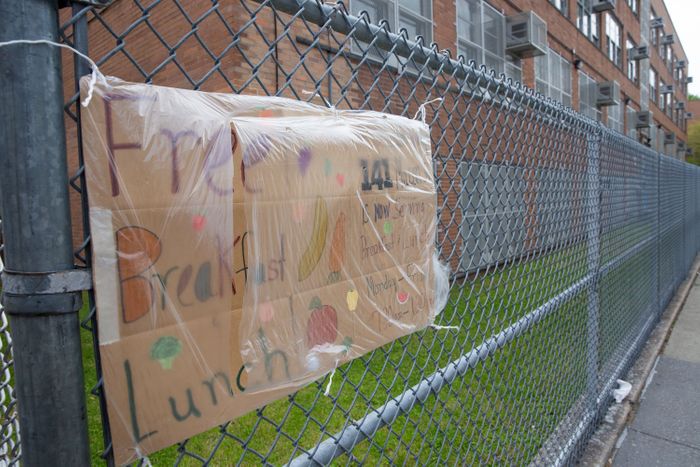
A public school in Bed-Stuy, Brooklyn, was giving away free food during the coronavirus outbreak. Photo: Ben Fractenberg/THE CITY
This story was originally published by Chalkbeat, a nonprofit news organization covering public education. Sign up for their newsletters here: ckbe.at/newsletters
Every public school student in New York City will soon receive more than $400 to help pay for food while school buildings are shut down, regardless of family income.
Through a federal relief effort, the state was recently approved to disperse the Coronavirus Pandemic Electronic Benefit Transfer, or P-EBT. The sweeping program will automatically send families the equivalent of about $5.70 per day to make up for meals that each student would have been eligible for while in school.
Because New York City is a universal free lunch district, providing no-cost meals to all 1 million students regardless of need, every child in a city-run public school qualifies. It adds up to about $420 per child — retroactive from the time buildings were shuttered in mid-March, through the end of the academic year in June. Across the state, the program will bring in more than $880 million in federal funds.
Charter and parochial students should also benefit, so long as their school participates in the federal school lunch program.
Anti-hunger activists who fought for universal free lunch in the city say the coming relief is unprecedented in scale and serves dual purposes: keeping children fed, and helping local businesses stay afloat.
Families, some of whom may be receiving public assistance for the first time, should not hesitate to use the money, said Joshua Goodman, a city spokesperson.
“This is an important program that is going to benefit a lot of people,” he wrote in an email. “This crisis is exactly what public benefits like P-EBT were made for, and there is no reason to feel reluctant to use it to take care of your family.”
Two Million Hungry
An estimated 2 million people in the city, the epicenter of the virus’s chokehold, are hungry. More than 500 schools have continued to serve as meal hubs since buildings shut down on March 16, providing bagged breakfasts and lunches to anyone who needs food.
Still, meal hubs can only go so far in meeting the need. With set hours, locations that may require traveling on public transit, and menus that don’t always meet dietary or religious restrictions, families may find it hard to access food served at schools.
Increased food benefits, meanwhile, have a well-documented effect of helping to boost the economy, as families can shop in local bodegas and markets.
“That’s money that immediately gets infused into the local economy,” said Liz Accles, executive director of the nonprofit Community Food Advocates. “People get benefits and they spend them right away because the needs are immediate.”
Families do not have to apply. For those already receiving food assistance or medicare, the additional funds will be added automatically to EBT or identification cards. Payments should begin in early June, according to the state.
For all others, benefits are expected to be mailed beginning late June.
The state is responsible for disbursing the money and is working with the New York education department to identify families who haven’t previously received public benefits.
Unlike previous rounds of federal stimulus support, families will qualify regardless of immigration status. The benefits will not count against the “public charge” rule, under which other public benefits could be a strike against someone’s chances of securing a green card or other kinds of visas.
City leaders said they are working on an information campaign so that parents know to expect the extra support. That will be crucial, Accles said, because families may be skeptical of spending the money if they are worried it was sent in error — and that they may need to eventually pay it back.
“We really want to make sure that people know what this is when they get it,” Accles said. “It’s essential and people really need the support.”
For more information, visit the state’s Office of Temporary and Disability Assistance website.
